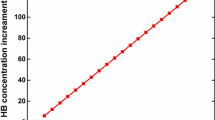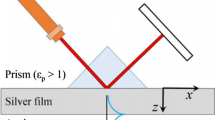Abstract
This paper presents the modeling of a novel Kron-5 (K5) prism-based Surface Plasmon Resonance (SPR) sensor to detect urea employing Aluminum arsenide (AlAs). The proposed SPR structure is designed based on a silver (Ag)-coated Kretschmann configuration. This structure contains AlAs to avoid Ag oxidation, as well as barium titanate for increased absorption, and black phosphorus for biorecognition element, respectively. For the detection process, the urea concentration of 0.625 gm/dl, 2.5 gm/dl and 5 gm/dl are used with the refractive indices (RIs) of 1.337. 1.339 and 1.342, respectively. The presented work is shown in three significant ways at 633 nm wavelength by exploiting the transfer matrix method. Firstly, the optimal performance of the proposed K5 prism-based structure is compared with BK7 and SK11-based structures, which have lower and higher refractive indexes compared to the proposed prism. Secondly, the optimal performance of the proposed structure is validated with respect to the RI of urea. Thirdly, an impact of AlAs in the proposed structure has been shown. The maximum achieved SPR parameters are sensitivity of 452.85°/RIU, quality factor of 93.37 \({\mathrm{RIU}}^{-1}\), detection accuracy of 0.65 and dip-of-figure-of-merit of 129,388.57 for the proposed sensor. Finally, the comparative study of SPR sensor performance for urea detection is presented.








Similar content being viewed by others
References
M. Eghbali, A. Farahbakhsh, A. Rohani, A.N. Pour, Urea biosensor based on immobilization of urease on ZnO nanoparticles. Orient. J. Chem. 31, 1237–1242 (2015). https://doi.org/10.13005/ojc/310284
J.F. Masson, Surface plasmon resonance clinical biosensors for medical diagnostics. ACS Sens. 2, 16–30 (2017). https://doi.org/10.1021/acssensors.6b00763
N.A. Jamil, P.S. Menon, F.A. Said, K.A. Tarumaraja, G.S. Mei, B.Y. Majlis, Graphene-based surface plasmon resonance urea biosensor using Kretschmann configuration. IEEE (RSM) (2017). https://doi.org/10.1109/RSM.2017.8069122
S. Pal, A. Verma, J.P. Saini, Y.K. Prajapati, Sensitivity enhancement using silicon-black phosphorus-TDMC coated surface plasmon resonance biosensor. Inst. Eng. Techn. Optoelec. 13, 196–201 (2019). https://doi.org/10.1049/iet-opt.2018.5023
B.D. Gupta, R.K. Verma, Surface plasmon resonance-based fiber optic sensors: principle, probe designs, and some applications. J. Sens. (2009). https://doi.org/10.1155/2009/979761
N.A. Jamil, N.B. Khairulazdan, P.S. Menon, A.R. Zain, A.A. Hamzah, B.Y. Majlis, Graphene-MoS2 SPR-based biosensor for urea detection. IEEE (ISESD) (2018). https://doi.org/10.1109/ISESD.2018.8605491
N. A. Jamil, P. S. Menon, G. S. Mei, S. Shaari, B. Y. Majlis, “Urea biosensor utilizing graphene- MoS2 and Kretschmann-based SPR”, IEEE InTENCON, 1973–1977 (2017). https://doi.org/10.1109/TENCON.2017.8228183
J. Homola, Surface plasmon resonance based sensors. Chem. Sens. Biosen. 4, 45–67 (2006). https://doi.org/10.1007/5346-014
H. Fu, S. Zhang, H. Chen, J. Weng, Graphene enhances the sensitivity of fiber optic surface plasmon resonance biosensor. IEEE Sens. 15, 5478–5482 (2015). https://doi.org/10.1109/JSEN.2015.2442276
K.L. Lee, C.W. Lee, W.S. Wang, P.K. Wei, Sensitive biosensor array using surface plasmon resonance on metallic nanoslits. J. Biomed. Opt. 12, 044023 (2007). https://doi.org/10.1117/1.2772296
L. E. Ronald, “Multiwavelength Surface Plasmon Resonance Sensor Designs for Chemical and Biochemical Detection”, PHD thesis, Dept. of Chemistry, Virginia Polytechnic Institute and State University, Ontario, Canada, (2013).
S.H. Choi, Y.L. Kim, K.M. Byun, Graphene-on-silver substrates for sensitive surface plasmon resonance imaging biosensors. Opt. Exp. 19, 458–466 (2011). https://doi.org/10.1364/OE.19.000458
R. Kumar, S. Pal, Y. K. Prajapati, S. Kumar, J. P. Saini, “Sensitivity Improvement of a MXeneimmobilized SPR Sensor with Ga-doped-ZnO for Biomolecules Detection”, IEEE Sensors, (2022).
A. Verma, A.K. Sharma, Y.K. Prajapati, On the sensing performance enhancement in SPR-based Biosensor using specific two-dimensional materials (Borophene and Antimonene). Opt. Mater. 119, 111355 (2021). https://doi.org/10.1016/j.optmat.2021.111355
V.K. Verma, S. Pal, C. Rizal, Y.K. Prajapati, Tunable and sensitive detection of cortisol using anisotropic phosphorene with a surface plasmon resonance technique: numerical investigation. Magnetochem. 8(3), 31 (2022). https://doi.org/10.3390/magnetochemistry8030031
A. Verma, A. Prakash, R. Tripathi, Sensitivity enhancement of surface plasmon resonance biosensor using graphene and air gap. Opt. Comm. 357, 106–112 (2015). https://doi.org/10.1016/j.optcom.2015.08.076
A.K. Sharma, A.K. Pandey, Blue phosphorene/ heterostructure based SPR sensor with enhanced sensitivity. IEEE Phot. Techn. Lett. 30, 595–598 (2018). https://doi.org/10.1109/LPT.2018.2803747
R. Kumar, A.S. Kushwaha, M. Srivastava, H. Mishra, S.K. Srivastava, Enhancement in sensitivity of graphene-based zinc oxide assisted bimetallic surface plasmon resonance (SPR) biosensor. Appl. Phys. A Mater. Sci. Proc. 124, 235 (2018). https://doi.org/10.1007/s00339-018-1606-5
S. Fouad, N. Sabr, Z.A.Z. Jamal, P. Poopalan, Surface plasmon resonance sensor sensitivity enhancement using gold-dielectric material. Int. J. Nanoelectron. Mater. 10, 149–158 (2017)
L. Liu, M. Wang, L. Jiao, T. Wu, F. Xia, M. Liu, W. Kong, L. Dong, M. Yun, Sensitivity enhancement of a graphene–barium titanatebased surface plasmon resonance biosensor with an Ag–Au bimetallic structure in the visible region. J. Opt. Soc. Am. B 36, 1108–1116 (2019). https://doi.org/10.1364/JOSAB.36.001108
P. Sun, M. Wang, L. Liu, L. Jiao, W. Du, F. Xia, M. Liu, W. Kong, L. Dong, M. Yun, Sensitivity enhancement of surface plasmon resonance biosensor based on graphene and barium titanate layers. Appl. Surf. Sci. 475, 342–347 (2019). https://doi.org/10.1016/j.apsusc.2018.12.283
M.S. Rahman, M.R. Hasan, K.A. Rikta, M.S. Anower, A novel graphene coated surface plasmon resonance biosensor with tungsten disulfide (WS2) for sensing DNA hybridization. Opt. Mater. 75, 567–573 (2018). https://doi.org/10.1016/j.optmat.2017.11.013
S.Y. Cho, Y. Lee, H.J. Koh, H. Jung, J.S. Kim, H.W. Yoo, J. Kim, H.J. Jung, Superior chemical sensing performance of black phosphorus: comparison with and graphene. Adv. Mater. 28, 7020–7028 (2016). https://doi.org/10.1002/adma.201601167
N. Mao, J. Tang, L. Xie, J. Wu, B. Han, J. Lin, S. Deng, W. Ji, H. Xu, K. Liu, L. Tong, Optical anisotropy of black phosphorus in the visible regime. Am. Chem. Soc. 138, 300–305 (2016). https://doi.org/10.1021/jacs.5b10685
L. Wu, J. Guo, Q. Wang, S. Lu, X. Dai, Y. Xiang, D. Fan, Sensitivity enhancement by using few-layer black phosphorus-graphene/TMDCs heterostructure in surface plasmon resonance biochemical sensor. Sen. Actua. B Chem. 249, 542–548 (2017). https://doi.org/10.1016/j.snb.2017.04.110
Y. Vasimalla, H.S. Pradhan, R.J. Pandya, SPR performance enhancement for DNA hybridization employing black phosphorus, silver, and silicon. Appl. Opt. 59, 7299–7307 (2020). https://doi.org/10.1364/AO.397452
H. Bach, N. Neuroth, The properties of optical glass (Springer, Berlin, 1998). https://doi.org/10.1007/978-3-642-57769-7
P.B. Johnson, R.W. Christy, Optical constants of the noble metals. Phys. Rev. B 6, 4370–4379 (1972). https://doi.org/10.1103/PhysRevB.6.4370
P.K. Maharana, T. Srivastava, R. Jha, On the performance of highly sensitive and accurate graphene-on-aluminum and silicon-based SPR biosensor for visible and near infrared. Plasmonics 9, 1113–1120 (2014). https://doi.org/10.1007/s11468-014-9721-4
J.B. Maurya, Y.K. Prajapati, V. Singh, J.P. Saini, R. Tripathi, Performance of graphene- based surface plasmon resonance sensor using silicon layer. Opt. Quant. Elect. 47, 3599–3611 (2015). https://doi.org/10.1007/s11082-015-0233-z
N. Mudgal, A. Saharia, A. Agarwal, G. Singh, ZnO and Bi-metallic (Ag–Au) layers based surface plasmon resonance (SPR) biosensor with BaTiO3 and graphene for biosensing applications. IETE J. Res. (2020). https://doi.org/10.1080/03772063.2020.1844074
A. Pal, A. Jha, A theoretical analysis on sensitivity improvement of an SPR refractive index sensor with graphene and barium titanate nanosheets. Optik 231, 166378 (2021). https://doi.org/10.1016/j.ijleo.2021.166378
B. Karki, A. Pal, Y. Singh, S. Sharma, Sensitivity enhancement of surface plasmon resonance sensor using 2D material barium titanate and black phosphorus over the bimetallic layer of Au, Ag, and Cu. Opt. Comm. 508, 127616 (2022). https://doi.org/10.1016/j.optcom.2021.127616
A. Srivastava, R. Das, Y.K. Prajapati, Effect of perovskite material on performance of surface plasmon resonance biosensor. IET Optoelectr. 14(5), 256–265 (2020). https://doi.org/10.1049/iet-opt.2019.0122
S.H. Wemple, J.M. Didomenico, I. Camlibel, Dielectric and optical properties of melt-grown. J. Phys. Chem. Solids 29, 1797–1803 (1968). https://doi.org/10.1016/0022-3697(68)90164-9
N. Mudgal, P. Yupapin, J. Ali, G. Singh, Graphene-Affinity Layer-Based Surface Plasmon Resonance (SPR) Biosensor for Pseudomonas Bacterial Detection. Plasmonics 2, 1–9 (2020). https://doi.org/10.1007/s11468-020-01146-.2
S. I. Ahmad, “Studies on some biophysical aspects of human renal excretory fluid”, Ph.D dissertation, Dept. Phys, JNTU, Hyderabad, India, 2010.
K.N. Shushama, M.M. Rana, R. Inum, M.B. Hossain, Sensitivity enhancement of graphene coated surface plasmon resonance biosensor. Opt. Quantun. Electron. 49, 381 (2017). https://doi.org/10.1007/s11082-017-1216-z
M.S. Rahman, M.S. Anower, M.R. Hasan, M.B. Hossain, M.I. Haque, Design and numerical analysis of highly sensitive Au-MoS2-graphene based hybrid surface plasmon resonance biosensor. Opt. Comm. 396, 36–43 (2017). https://doi.org/10.1016/j.optcom.2017.03.035
S. Pal, A. Verma, Y.K. Prajapati, J.P. Saini, Figure of Merit Enhancement of Surface Plasmon Resonance Biosensor Using Ga-Doped Zinc Oxide in Near Infrared Range. Phot. Sens. (2020). https://doi.org/10.1007/s13320-020-0583-4
R. Çelen, Y. Ulcay, Baryum Titanatin Tekstilde Elektromanyetik Kalkanlama Uygulamalarinda KullanIMI. J. Ulu. Uni. Fac. Eng. 23, 29–44 (2018). https://doi.org/10.17482/uumfd.398903
F. A. Said, P. S. Menon, M. N. Nawi, A. R. Zain, A. Jalar, B. Y. Majlis, “Copper-graphene SPR-based biosensor for urea detection”, (ICSE) IEEE, 264–267 (2016). https://doi.org/10.1109/SMELEC.2016.7573642.
S. Pal, A. Verma, Y.K. Prajapati, J.P. Saini, Influence of black phosphorous on performance of surface plasmon resonance biosensor. Opt. Quantun. Electron. 49, 403 (2017). https://doi.org/10.1007/s11082-017-1237-7
F.A. Said, P.S. Menon, T. Kalaivani, M.A. Mohamed, A. Abedini, S. Shaari, B.Y. Majlis, V. Retnasamy, FDTD analysis of structured metallic nanohole films for LSPR-based biosensor. IEEE (RSM) (2015). https://doi.org/10.1109/RSM.2015.7355024
H. Raether, “Surface plasmons on smooth surfaces, in Surface plasmons on smooth and rough surfaces and on gratings”, Springer, Berlin, pp 4–39 (1988)
W.M. Mukhtar, S. Shaari, A.A. Ehsan, P.S. Menon, Electrooptics interaction imaging in active plasmonic devices. Opt. Mater. Exp. 4, 424 (2014). https://doi.org/10.1016/j.snb.2012.07.015
L. Wu, Y. Jia, L. Jiang, J. Guo, X. Dai, Y. Xiang, D. Fan D, Sensitivity improved SPR biosensor based on the MoS2/graphene–aluminum hybrid structure. J. Ligh. Techn. 35, 82–87 (2016). https://doi.org/10.1109/JLT.2016.2624982
B.J. Chu, D.R. Chen, G.R. Li, Q.R. Yin, Electrical properties of Na1/2Bi1/2TiO3–BaTiO3 ceramics. J. Eur. Cer. Soc. 22, 2115–2121 (2002). https://doi.org/10.1016/S0955-2219(02)00027-4
I. Pockrand, Surface plasma oscillations at silver surfaces with thin transparent and absorbing coatings. Surf. Sci. 72, 577–588 (1978). https://doi.org/10.1016/0039-6028(78)90371-0
A. Shalabney, I. Abdulhalim, Electromagnetic fields distribution in multilayer thin film structures and the origin of sensitivity enhancement in surface plasmon resonance sensors. Sens. Act. A 159, 24–32 (2010). https://doi.org/10.3390/s20092445
Y. Vasimalla, H. S. Pradhan, “Performance Enhancement of SPR sensor in NIR-Region for urea detection using MoS2-Dielectric materials- MoS2 based structure, in IEEE-ASIANCON, 1-4 (2021). https://doi.org/10.1109/ASIANCON51346.2021.9544743
Acknowledgements
This research did not receive any specific grant from funding agencies in the public, commercial or not-for-profit sectors.
Author information
Authors and Affiliations
Corresponding author
Additional information
Publisher's Note
Springer Nature remains neutral with regard to jurisdictional claims in published maps and institutional affiliations.
Rights and permissions
About this article
Cite this article
Vasimalla, Y., Pradhan, H.S. Modeling of a novel K5 prism-based surface Plasmon resonance sensor for urea detection employing Aluminum arsenide. J Opt 52, 242–253 (2023). https://doi.org/10.1007/s12596-022-00878-0
Received:
Accepted:
Published:
Issue Date:
DOI: https://doi.org/10.1007/s12596-022-00878-0




